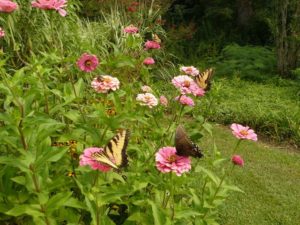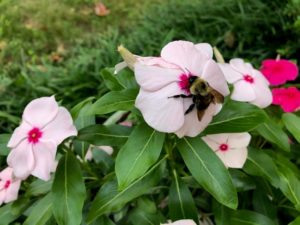It is easy to develop a vision for your garden in the spring, finding new ideas, and the plants that can transform that concept into reality. As the seasons progress, the days heat up, and the spring bloomers fade away, it is more difficult to bring life and color to the garden. If you need inspiration, maybe it is time to visit the Northern Neck Master Gardeners’ (NNMG) Shoreline Demonstration Garden at the Reedville Fishermen’s Museum.
According to NNMG Sue Lindsey, the garden was designed to demonstrate the principles of a living shoreline using native plants.
“The plants hold the soil, stabilize the bank, absorb the runoff from the adjacent parking lot, and trap sediment and pollutants that would otherwise impact the waters of Cockrell Creek and the Chesapeake Bay,” said Lindsey. “The garden provides food and shelter for wildlife and offers sustenance for a range of pollinators. It can also inspire many gardeners.”
The plantings illustrate a changing garden palette throughout the growing season. Each month reveals new swathes of color, diverse textures, and varied shape and form.

By late June, the upper bed is dominated by tall stands of red beebalm, clumps of bright yellow tickseed, and the last flowerings of blue and purple Stokes’ aster. Tall plumes of white wandflower ‘whirling butterflies’ bloom all summer, waving in the breeze. When the stalks get too long and straggly, they are cut back and new flower stems appears. Mid-summer brings color to the lower bed with black-eyed Susans creating a backdrop of yellow flower clusters. These will be joined by more splashes of gold atop the spectacular, towering cup plants, which can grow up to eight feet tall. New York ironweed thrusts purple spikes 6 feet high to dominate the landscape in August and September. As summer moves into fall, yellow ‘fireworks’ goldenrod fills the northern corner, while purple asters cascade down the slope.
“The rains we received seem to have put some of these plants on steroids. They are blooming like never before,” said Lindsey. “And the same can be said of the many uninvited guests that crowd out the lower region of the garden. Weed control is an on-going battle for the NNMG volunteers who maintain the garden. There’s a place for everything in the Reedville Fishermen’s Museum Garden. Well, most things, we have eliminated the highly invasive phragmites and we fight the good fight against poison ivy.”
The Shoreline Garden is located next to the Reedville Fishermen’s Museum and behind Bethany United Methodist Church. It is always open, has interpretative signage, and the plants are labeled. The “Guide to the RFM Garden” can be viewed online at https://nnmg.org/blog/reedville-fishermens-museum-shoreline-garden/. There is also an illustrated plant directory, with information on all the garden’s plants.


